
HMS Loch Insh was a Loch-class frigate of the Royal Navy, named after Loch Insh in Scotland. She was built by Henry Robb of Leith and launched on 10 May 1944. After service at the end of World War II she was decommissioned, but reactivated in 1950 and served, mostly in the Persian Gulf, until 1962. The ship was sold to the Royal Malaysian Navy in 1963 and renamed KD Hang Tuah (F433). She was scrapped in 1977.

HMS Lynx (F27), was a Leopard-class Type 41 anti aircraft frigate of the Royal Navy, named after the lynx.
Sixteen ships of the Royal Navy have been named HMS Mermaid after the mermaid:

HMS Dido was a Royal Navy (RN) Leander-class frigate. Entering service in 1961, Dido was involved in the Indonesia–Malaysia confrontation, served with NATO's Standing Naval Force Atlantic on several occasions, and was one of the frigates used for the filming of the drama series Warship.
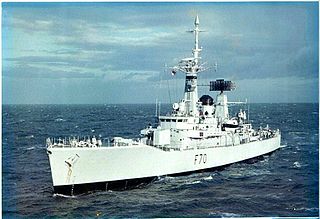
HMS Apollo was a batch 3B broadbeam Leander-class frigate of the Royal Navy. She was, like the rest of the class, named after a figure of mythology. Apollo was built by Yarrow Shipbuilders of Scotstoun. She was launched on 15 October 1970 and commissioned on 28 May 1972, making her the penultimate Leander.
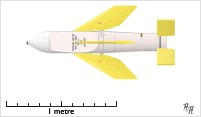
Seacat was a British short-range surface-to-air missile system intended to replace the ubiquitous Bofors 40 mm gun aboard warships of all sizes. It was the world's first operational shipboard point-defence missile system, and was designed so that the Bofors guns could be replaced with minimum modification to the recipient vessel and (originally) using existing fire-control systems. A mobile land-based version of the system was known as Tigercat.

The Royal Malaysian Navy is the naval arm of the Malaysian Armed Forces. RMN is the main agency responsible for the country's maritime surveillance and defense operations. RMN's area of operation consists of 603,210 square kilometers covering the country's coastal areas and Exclusive Economic Zones (EEZ). RMN also bears the responsibility of controlling the country's main Sea Lines of Communications (SLOC) such as the Straits of Malacca and the Straits of Singapore and also monitors national interests in areas with overlapping claims such as in Spratly.

HMS Yarmouth was the first modified Type 12 frigate of the Rothesay class to enter service with the Royal Navy.
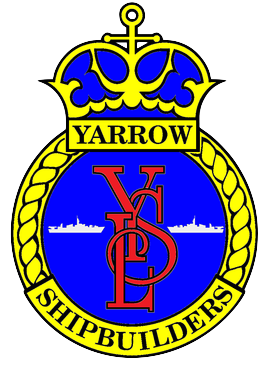
Yarrow Shipbuilders Limited (YSL), often styled as simply Yarrows, was a major shipbuilding firm based in the Scotstoun district of Glasgow on the River Clyde. It is now part of BAE Systems Surface Ships, owned by BAE Systems, which has also operated the nearby Govan shipyard since 1999.

The Type 41 or Leopard class were a class of anti-aircraft defence frigates built for the Royal Navy and Indian Navy in the 1950s. The Type 41, together with the Type 61 variant introduced diesel propulsion into the Royal Navy, the perceived benefits being long range, low fuel use, reduced crew, and reduced complexity.

BAPFerré(DM-74) was a Daring-class destroyer in service with the Peruvian Navy from 1973 to 2007. She was built by Yarrow Shipbuilders and completed for the Royal Navy in 1953 as HMS Decoy (D106).
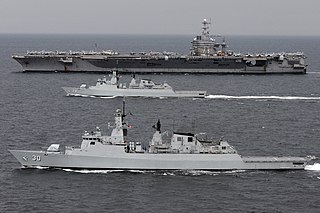
The Lekiu-class frigates are a class of frigates of the Royal Malaysian Navy. They are the largest and most modern surface combatants of the Royal Malaysian Navy, until the Maharaja Lela-class frigates are completed. The class comprises two vessels, KD Jebat and KD Lekiu. The class is named after the second ship of the class which was launched before Jebat.

The Kasturi-class corvettes are two ships of the Royal Malaysian Navy, KD Kasturi and KD Lekir. They were acquired in the mid-1980s. The two ships constitute the Malaysian Navy's 22nd Corvette Squadron, their homeport being Lumut. After about 25 years of service, they underwent an extensive modernisation known as Service Life Extension Program (SLEP) starting in 2009, enabling them to be employed for another 10 to 15 years. They have since been returned to active duty.

KD Jebat is a Lekiu-class guided missile frigate currently serving in the Royal Malaysian Navy and one of the major naval assets for Malaysia. Jebat serves in the 23rd Frigate Squadron of the Royal Malaysian Navy.

The Ghana Navy (GN) is the naval warfare organizational military branch of the Ghanaian Armed Forces (GAF). The Ghanaian Navy, along with the Ghanaian Army (GA) and Ghanaian Air Force (GHF), make up the Ghanaian Armed Forces (GAF) which are controlled by the Ghanaian Ministry of Defence (MoD).

HMS Fittleton, originally named HMS Curzon, was a wooden-hulled Ton-class minesweeper of the Royal Navy which spent most of her career in the Royal Naval Reserve. She was sunk in a collision with HMS Mermaid on 20 September 1976 whilst en route to Hamburg for an official visit. Twelve naval service personnel lost their lives, making this the worst peacetime accident involving the Royal Naval Reserve.

The QF 4 inch Mk XVI gun was the standard British Commonwealth naval anti-aircraft and dual-purpose gun of World War II.

HMS Mermaid was a Modified Black Swan-class sloop of the Royal Navy. Mermaid saw service as a convoy escort during the Second World War, taking part in the sinking of two German submarines while escorting Arctic convoys to and from the Soviet Union.

KDRahmat was a frigate operated by the Royal Malaysian Navy. The ship was ordered in 1966 as Hang Jebat.
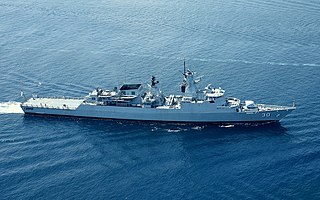
KD Lekiu is a Lekiu-class guided missile frigate currently serving in the Royal Malaysian Navy and one of the major naval assets for Malaysia. Together with her sister ship Jebat, Lekiu serves in the 23rd Frigate Squadron of the Royal Malaysian Navy.


















